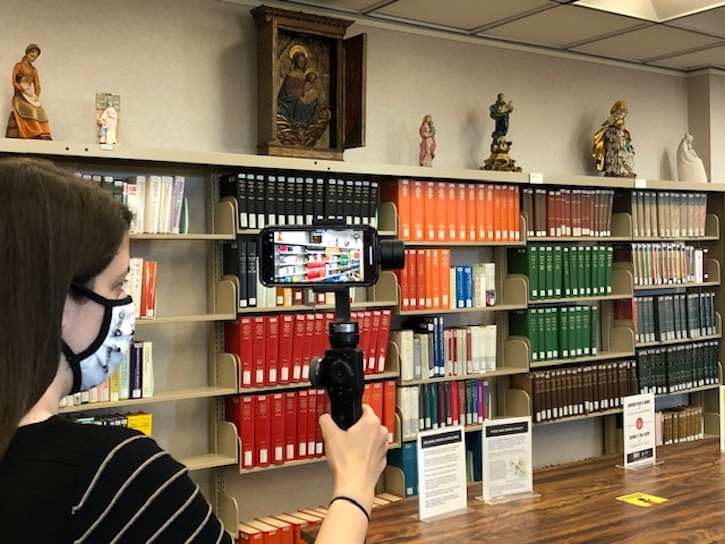University Libraries

One Year Later: What We Learned From Teaching During the Pandemic
By Library teaching faculty
In March 2020, the looming threat of the pandemic forced the University of Dayton campus to move to online learning. Like many other teaching faculty, the teaching librarians in the University Libraries had to learn how to teach online — and quickly. We learned lots of new technologies — Zoom, Snagit, Warpwire, Jamboard, Qualtrix, Kahoot, LibWizard and more — in order to teach students information literacy and the critical thinking skills that go along with doing research. As we mark one year of teaching mostly online, we reflect on what this sudden switch has meant for us.
Fun, flexibility
Katy Kelly, associate professor and coordinator of marketing and engagement: “I learned I have less stage fright when teaching a class on Zoom. Is this how a streamer on YouTube or Twitch feels? I enjoy the variety of ways that students can participate during a class: chat, reactions, shared screens, breakout rooms, etc. Although it can feel like I’m teaching in a virtual box, I think there’s a lot of opportunity for fun and flexibility online. I plan on adapting what I’ve liked about Zoom, Jamboard and other tools to in-person learning in the fall.”
‘Being vulnerable in your teaching is OK’
Stephanie Shreffler, associate professor and collections librarian/archivist: “I learned that being vulnerable in your teaching is OK! Back in the spring and early summer as we were learning to navigate Zoom and to create instructional videos, it was OK if I said to a class, “Give me a moment; I haven’t done this before; bear with me while I figure this out.” It made me more flexible with my teaching and better able to create a new plan on the fly. Like Katy, I’ve found many of the online tools to be quite valuable and plan to continue using them in the classroom in the fall.”
‘Students are incredibly graceful’
Zachary Lewis, assistant professor and student success librarian: “I learned that making mistakes is OK and that UD’s students are incredibly graceful when it comes to trying new things. My instruction routine didn’t work with distance learning, and the Libraries’ instruction team taught me a lot of new tools and strategies for remote teaching. At first I was nervous about adapting to a new environment — what if I messed everything up? Fast forward a year, and I’m much more comfortable with adjusting lesson plans on the fly, brushing off mistakes and implementing new teaching strategies. I’m hoping to bring this new confidence into the classroom in the fall and to continue trying new things.”
Confidence in making videos, tutorials
Kayla Harris, assistant professor and librarian/archivist: “There were several things that I had wanted to experiment with for in-person instruction that I never found time for, yet the switch to remote forced me to find the time. For example, I liked the idea of videos or tutorials as homework to prepare for a class visit to the Marian Library. This past year, I was able to become comfortable and confident making asynchronous tutorials and videos in several platforms that could be used to complement in-person instruction or on their own. But I’m still really excited to get back to engaging students with archival artifacts in person.”
Support extends beyond class times
Bridget Retzloff, lecturer and librarian: “Like many of my colleagues, I was nervous to try new tools and techniques made necessary by the pandemic. But I also found the students and faculty I worked with to be very kind, patient and helpful as we navigated new environments. I like the flexibility that can be offered by recording videos before or instead of a synchronous library instruction session. When students are learning about how to search in library catalogs and databases for the first time, I like that they can watch a short three-minute video with tips and techniques when they need it. Our support can now reach beyond the time we are with students in class in new ways.”
Sharing successes, working together
Heidi Gauder, professor and coordinator of research and instruction: “I learned that flexibility was key in working with faculty in order for both the library and the faculty to achieve the mutual goal of student learning. We offered asynchronous videos and tutorials; we became proficient in Zoom; and we have slowly begun to resume in-person sessions. Our teaching team continued to share resources and teaching techniques, and together we worked to meet the needs of our students and faculty.”
